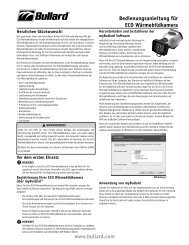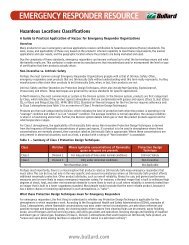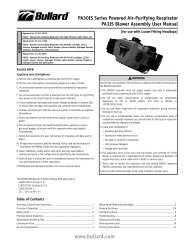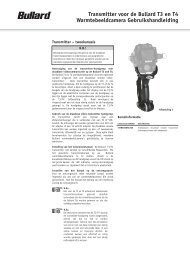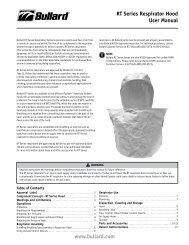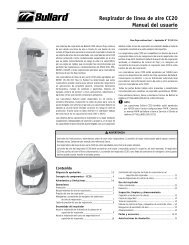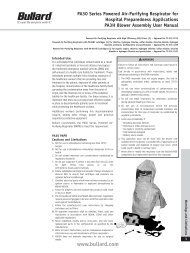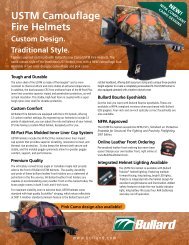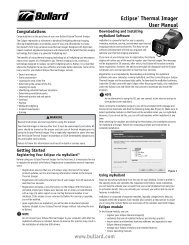88E Series Airline Respirator User Manual - Bullard
88E Series Airline Respirator User Manual - Bullard
88E Series Airline Respirator User Manual - Bullard
You also want an ePaper? Increase the reach of your titles
YUMPU automatically turns print PDFs into web optimized ePapers that Google loves.
Installing Headband into Inner Shell<br />
1. Turn inner shell and headband suspension upside down.<br />
2. Place headband inside shell with brow pad facing front of<br />
shell.<br />
3. Insert keys into respective key slots. Push firmly until keys<br />
snap into place. (Figure 8)<br />
4. Insert inner shell into helmet with front of shell tilted down.<br />
Align round hole located at front of shell with washer at<br />
inside front of helmet. Press back of shell into helmet until it<br />
snaps in place.<br />
USING THE 88CS CHIN STRAP<br />
1. Attach chin strap to inner shell by sliding chin strap loop<br />
over hook. (Figure 9)<br />
2. Put helmet on your head. Adjust chin strap length with the<br />
plastic slide.<br />
OPTIONAL LENS COVERS<br />
1. If desired, apply optional lens covers (88VXLC), designed to<br />
protect the respirator’s plastic lens. Apply 2-3 lens covers<br />
at a time.<br />
2. When lens becomes soiled, remove by pulling tab at edge<br />
of lens cover to clear your vision.<br />
Attaching Cape to Helmet<br />
1. Place cape on table or workbench. (Figure 4)<br />
2. With window frame open, place helmet on top of cape.<br />
3. Line up the hook-shaped catch on the cape with the front<br />
center of the helmet. (Figure 4) Catch should firmly engage<br />
under bottom front edge of helmet.<br />
NOTE: Installation is easiest when started at the front of<br />
cape and helmet.<br />
4. Ease cape rim completely into the groove along helmet<br />
edge, working your way<br />
to the back. Be certain cape is completely in place at every<br />
point along helmet’s bottom edge.<br />
5. Snap the over-center clamp to tighten cable and hold cape<br />
snugly on helmet.<br />
6. Close and latch window frame.<br />
Installing Breathing Tube Assembly into<br />
<strong>Respirator</strong> Helmet<br />
1. Connect breathing tube assembly to helmet by screwing<br />
plastic hose connector to fitting located on the side of the<br />
helmet. Turn clockwise to tighten. (Figure 10) Ensure you<br />
are using a <strong>Bullard</strong> 88VXBT. The name and part number are<br />
stamped on the side of the breathing tube sleeve. The date<br />
of manufacture is stamped on the inside of the sleeve.<br />
3<br />
WARNING<br />
Figure 8<br />
Figure 9<br />
Figure 10<br />
Do not wear this respirator if any of the following conditions exist:<br />
•You CANNOT escape without the aid of the respirator.<br />
• Atmosphere contains less than 19.5% oxygen or is oxygen enriched.<br />
• Work area is poorly ventilated.<br />
• Unknown contaminants are present.<br />
• Contaminants are in excess of regulatory requirements.<br />
LEAVE work area immediately if:<br />
• Any respirator component becomes damaged.<br />
• Airflow into respirator helmet stops or slows down,<br />
• Air pressure gauge drops below the minimum specified in the Breathing Air Pressure Table.<br />
• Breathing becomes difficult.<br />
• You become dizzy, nauseous, too hot, too cold or ill.<br />
• You taste, smell or see contaminants inside the respirator helmet.<br />
• Your vision becomes impaired.<br />
DO NOT leave respirator in work area. Respirable dust contaminants can remain suspended in the air for more than one hour<br />
after work activity ceases, even though you may not see them. Proper work practice requires you to wear the respirator<br />
until you are outside the contaminated area. Failure to don, doff and store the respirator outside of the contaminated area<br />
could result in exposure to contaminants.<br />
RESPIRATOR USE<br />
WARNING<br />
Do not use this respirator in poorly ventilated areas or<br />
confined spaces such as tanks, small rooms, tunnels or<br />
vessels unless the confined space is well ventilated, and<br />
contaminant concentrations are below the protection<br />
level of the respirator. In addition, follow all procedures<br />
for confined space entry, operation and exit as defined in<br />
applicable regulations and standards.<br />
Donning<br />
Before donning, make sure there is no dirt, dust or contamination<br />
inside the helmet.<br />
1. Connect the <strong>Bullard</strong> air supply hose to the air source<br />
supplying clean breathable air. Turn on the breathing air<br />
source.<br />
2. Connect breathing tube assembly to air supply hose.<br />
Connect quick-disconnect fitting on breathing tube<br />
assembly to quick-disconnect coupler on air supply hose.<br />
Once fitting is secured, release coupling sleeve to lock<br />
fittings together. Pull on both hoses to make sure they are<br />
attached securely. Check to assure air is flowing properly<br />
into the hood.<br />
3. Adjust air pressure at point-of-attachment to within the<br />
approved pressure range. See the Breathing Air Pressure<br />
Table (page 1) for approved pressure ranges.<br />
Check the air flow indicator/low flow alarm device<br />
attached to the air flow control device to assure that<br />
the indicator is reading within the green arc. Do not use<br />
respirator if indicator reads in the red zone.<br />
4. With air still flowing, lower <strong>88E</strong> <strong>Series</strong> respirator helmet<br />
onto your head for a comfortable fit.<br />
5. Position headband for a comfortable fit. See instructions<br />
on page 2 for proper headband sizing.<br />
6. Pull elastic chin strap under your chin and adjust for a<br />
secure and comfortable fit. The chin strap will help balance<br />
the helmet and should be worn at all times.<br />
7. Be sure that the knitted inner neck cuff fits snugly around<br />
your neck to help provide a barrier to airborne contaminants.<br />
8. With breathing tube assembly attached to the helmet,<br />
fasten belt around waist or hips and adjust for comfort.<br />
9. Pull respirator cape around your body and secure sides by<br />
connecting the snap hooks.<br />
10. Recheck air pressure at the point-of-attachment and the<br />
air flow indicator at the belt (mounted on the air flow<br />
control device). Adjust if necessary.<br />
11. With air still flowing into the respirator, you are now ready<br />
to enter the work area.<br />
Use<br />
During use, periodically check the flow indicator at the belt to<br />
assure that adequate air flow is being supplied to helmet.<br />
Doffing<br />
When finished working, leave work area wearing respirator<br />
and with air still flowing. Once outside contami-nated area,<br />
remove respirator and then disconnect the air supply hose<br />
using the quick-disconnect fittings.



